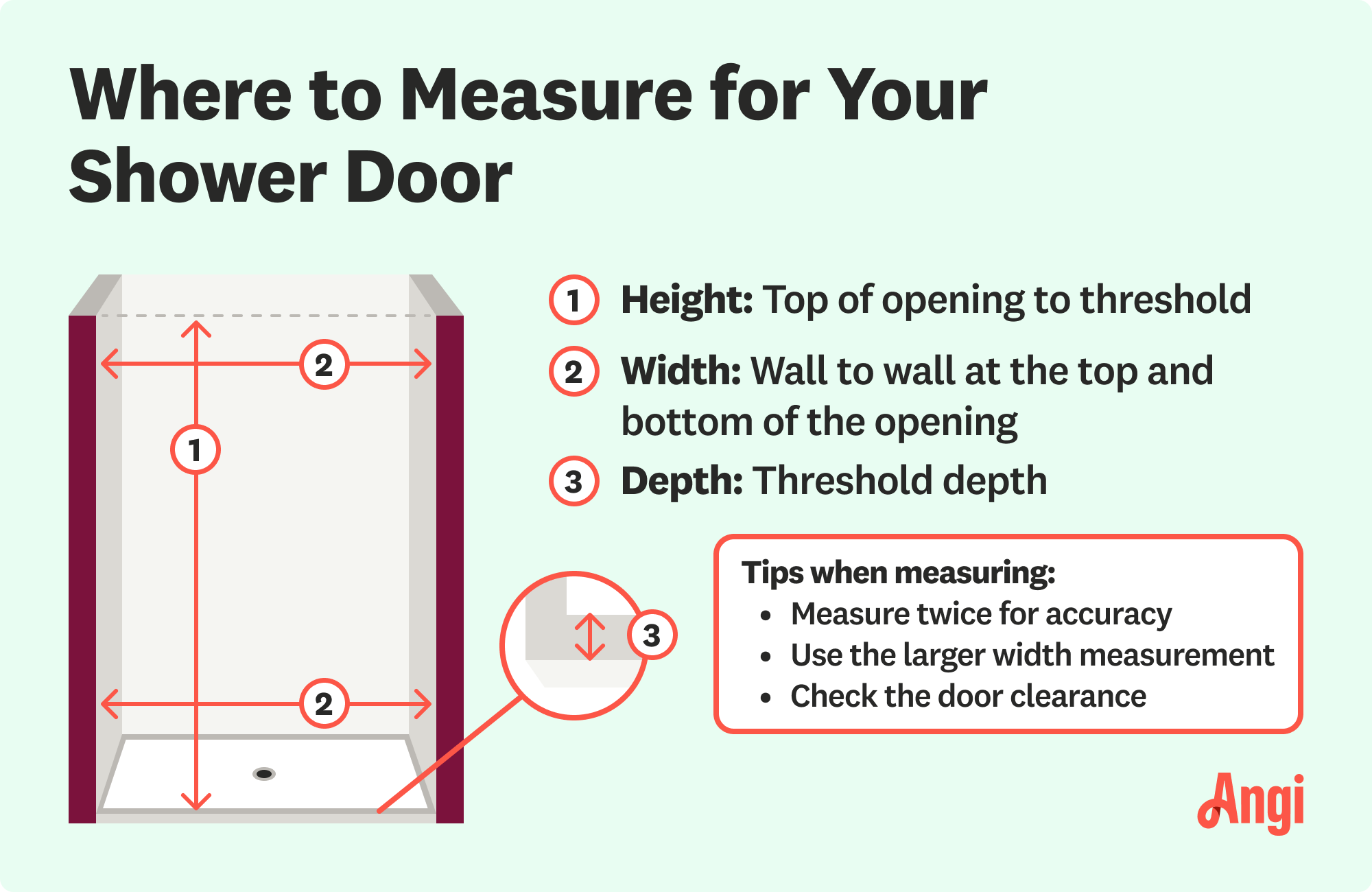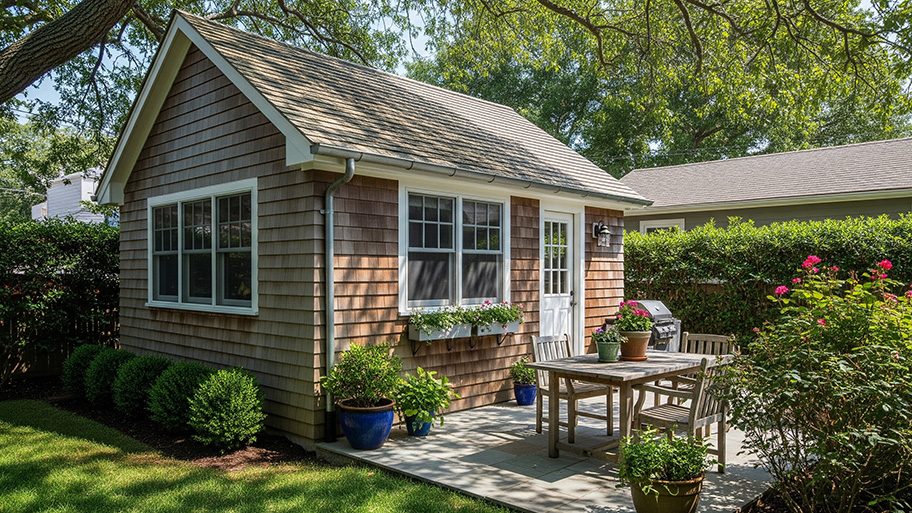
If your bathroom vanity top is damaged or cracked, removing and installing a new one can be an easy project to tackle. Learn the cost of replacing your vanity top.
Glass shower doors have a transparent installation process, but it can still be tricky


This project can be costly in more ways than one. Hire a pro to get the job done right the first time, avoid potential injury, and eliminate budget-breaking DIY mistakes.
If you don’t have the budget for a full bathroom remodel, installing glass doors in your shower will give your space an instant makeover. Unfortunately, learning how to install a shower door is a complicated DIY unless you have experience. You’ll need to ensure everything is level, plumb, secure, and sealed—but the right guidance can help. Here’s how to install a shower door in 17 straightforward steps.

Start by grabbing a measuring tape and finding the dimensions of three key areas:
Height of the door opening from the threshold to the top of the shower.
Width of the shower opening. You should measure the width in at least two spots in case the walls are uneven.
Depth of the shower’s threshold or base.
Start by cutting the base track to the appropriate length using your hacksaw. Your base track should run the length of the threshold and fit tightly between the shower walls. Make sure you file the rough edge with a cut file and vacuum up the metal filings.
Install the base track on the threshold. Use your tape measure to ensure it’s completely centered. Before you seal it, mark the location with scotch tape or a pencil in case it slides out of place.
Next, plan where you’ll put your hinge-side jamb. The hinged portion of the door goes on the wall furthest from the showerhead. Fit the bottom of the jamb into the base track and press it flush against the wall. Use a level to ensure it’s plumb, but be careful not to move the base track.
Once it’s flush and plumb, use your pencil to mark the screw holes where you’ll need to drill. This will be where you screw your jamb in place against the wall.

Remove the jamb, then carefully drill screw holes in the tile over your pencil markings using your 3/16-inch masonry bit. Insert the wall anchors into the drill holes. If the anchors are stubborn, try tapping them into place with a plastic mallet.
Put your jamb back up on the wall. Make sure the screw holes align with the anchors and the end of the jamb is in place on the bottom track. Screw the jamb in place.
Some doors have a strike-side jamb on the opposite end of the threshold (on the same wall as your showerhead). If that’s the case, follow the same installation process as the hinge-side jamb.

Glass doors can get pretty heavy, so have a helper give you an extra hand. Lift and put the door in place so the hinges swing outward and away from the shower. Slide the hinge rail into the jamb, and use a level to ensure it’s plumb. If it’s not plumb, then readjust.
Have your helper hold the door in place. From here, you’ll need to drill holes to screw the hinge rail into the jamb. There should be screw holes in the hinge rail. Drill through the holes and into the jamb to create 7/32-inch pilot holes. Take the screws that came with your door, and screw your hinge rail into place.
Some doors come with a second glass panel that attaches to the strike-side jamb. You’ll need to attach the magnetic strike rail on the edge closest to the door. This holds the door in place when it’s shut. Slide the strike rail into place, make sure it’s secure, and move on to the next step.

Install the second glass panel in the strike-side jamb. In a previous step, you should have already screwed the jamb into the wall. From here, fit the glass panel into the base track and carefully slide it into the strike-side jamb. Make sure it’s plumb.
Pull your shower door closed and carefully measure the top edge of the shower opening. Cut the header to the appropriate length using your hacksaw. Smooth the edge with a cut file.
Lift the header to the upper edge of the door and slide it into place. On hinged doors, the shorter arm of the header should face outward. Keep in mind that some headers have screw holes. If that’s the case, you’ll need to screw your header into the corresponding jamb. Before marking and drilling your 7/32-inch pilot holes, ensure the header is level.

Tackle one corner at a time. Find the area where your base track meets the vertical frame. Drill a pilot hole, then screw the pieces together. Do the same thing around all four corners of your frame.
Your shower door should come with a hardware kit that includes door handles, and there should be pre-drilled holes for the screws. Set your handles over the screw holes and tighten the screws until they’re firmly in place.
Your drip rail should match the width of your door. Remove the vinyl strip, measure the rail, and cut it to the appropriate length using your hacksaw. Smooth the rough edge with a cut file, then slip the vinyl strip back in place. Crimp the edges of the drip rail with pliers to secure the vinyl, then trim the excess with a utility knife.
Your drip rail should have mounting holes where you screw it into the bottom of the door frame. Line up your drip rail along the bottom of your door (the vinyl should face down), and drill a 7/32-inch pilot hole through the mounting hole and into the door frame. Take care to stay low enough to avoid drilling into the glass. Use screws to secure your drip rail in the door frame.
The final step is waterproofing your shower. You’ll need to seal the edges with silicone caulk. Take your gun and apply caulk along the inside and outside edges of the base track and the inside edges of each jamb. Smooth out the caulk, wait for it to dry, and your shower is ready to go.
Shower door installation is a challenging project, and these common mistakes can lead to leaks, damage, or a door that doesn’t function properly:
Skipping Accurate Measurements: Measuring in only one spot or rounding measurements can result in gaps or a door that doesn't fit. Always measure width in multiple locations since walls are rarely perfectly straight.
Installing the Base Track Off-Center: An uncentered base track throws off the entire installation. Double-check your measurements and use tape or pencil marks to position everything properly before sealing.
Rushing the Plumb and Level Checks: A door that's not perfectly plumb will swing open or closed on its own and may not seal properly.
Using the Wrong Drill Bit: Standard drill bits can crack tile. To avoid causing damage, use a masonry bit when drilling into tile or stone surfaces.
Inadequate Sealing: Skipping caulk or applying it poorly can lead to water damage. Seal all inside and outside edges of the base track and jambs thoroughly.
These mistakes can be costly to fix. Some problems require tearing out the entire installation and starting over, which is why hiring a pro is worth the investment.
For most homeowners, installing a glass shower door costs $550 to $1,400. You can save on labor costs by doing the work yourself, but this isn’t a simple DIY project. Glass panels are heavy, can shatter if not properly installed, and require different installation steps depending on the door type. You may not save significantly (or at all) if a shoddy job requires shower repairs.
Unless you have experience, it’s better to let a shower door installer near you handle this job.
Some frameless shower doors weigh up to 170 pounds, potentially making DIY projects dangerous. A pro can safely adjust or replace your shower door so you can return to your morning routine.
From average costs to expert advice, get all the answers you need to get your job done.

If your bathroom vanity top is damaged or cracked, removing and installing a new one can be an easy project to tackle. Learn the cost of replacing your vanity top.

Sink installation costs depend on the type of sink, the material, and the labor. This guide can help you budget for your project—from pedestal to farmhouse.

Accessory dwelling units can be a smart investment, but your ADU cost will depend on the size, type, and materials you choose. Here’s how it breaks down.

What is a range in a kitchen, and which is best for your cooking needs? Learn about the various types of kitchen ranges and what to consider before buying one.

Knowing how to install a shower requires some skill and experience, but a shower enclosure installation is a doable DIY project if you follow some basic steps.

Small bathroom remodel costs depend on a number of factors—like what exactly you’re upgrading and the size of the room. This guide will help you budget.